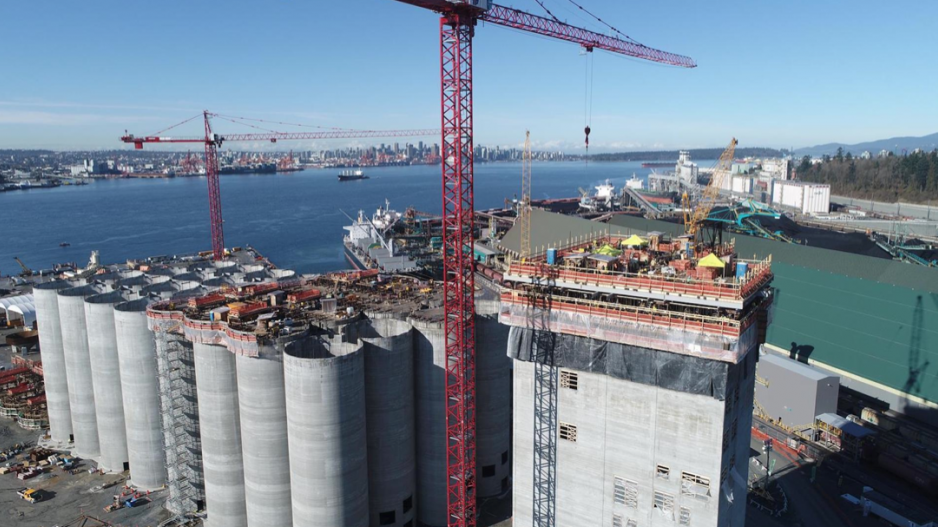While its local economic impact might be minimal, the first grain terminal to be built within the Port of Vancouver’s jurisdiction since the 1960s sets the stage for a new age of Canadian grain exports.
The G3 Terminal has been under construction since March 2017 and is expected to be completed by early 2020. The $600 million project, located at Lynnterm West Gate on the North Shore, is a joint venture between G3 Global Holdings and Western Stevedoring Co. Ltd.
Brett Malkoske, G3’s vice-president of business development and communications, based out of Winnipeg, said once the terminal is completed it will be the first of its kind with a loop track that can accommodate three fully loaded, 134-car trains.
He added that the system could reduce travel time from the Prairies (where the majority of the country’s wheat is grown) to port and back again by between 40% and 50%.
Malkoske said Canada’s wheat industry is in dire need of the terminal.
“The challenge is not just to build a grain terminal. It is to build a next-generation grain terminal that would add the efficiency that Canada’s grain supply desperately needs. You don’t have to look further than recent headlines to understand the challenges facing railways in meeting the demand to move huge volumes of grain to port.”
In early March, the Canadian Federation of Agriculture held a press conference asking the federal government to come up with a plan to resolve the issues plaguing the wheat industry: mainly railcar bottlenecks that have delayed shipment of the commodity to market.
Immediately following the March 5 departure of Canadian National Railway (TSX:CNR) CEO Luc Jobin, interim CEO Jean-Jacques Ruest vowed that CN would quickly improve the movement of western Canadian grain.
“We apologize for not meeting the expectations of our grain customers, nor our own high standards,” Ruest said in a March 7 press release. “The entire CN team has a sense of urgency and is fully focused on getting it right for farmers and our grain customers, regaining the confidence of Canadian businesses, and protecting Canada’s reputation as a stable trade partner in world markets.”
Malkoske said G3 Canada had been worried that the wet West Coast climate would hamper the grain terminal’s construction; however, that hasn’t been an issue so far, and the project is currently ahead of schedule.
He noted another challenge is squeezing all the infrastructure into a tight 58-acre site.
“To combat local traffic concerns we have prepared concrete on-site, keeping several thousands of trucks off the road. In addition to peak work period shuttle buses, our major work shifts are set to change in non-rush-hour periods.”
Malkoske said the terminal’s 48 grain silos will be perpendicular to the waterline, leaving a clearer sightline from North Vancouver to the shore. The terminal, which sits on federal land managed by the Vancouver Fraser Port Authority (VFPA), will include more than 180,000 tonnes of storage and will handle cereal grains, oilseeds, pulses and specialty crops.
The Canadian Wheat Board (CWB) was an agricultural marketing board run out of Winnipeg that was established in 1935 and was largely the sole buyer and seller of Prairie wheat and barley. Referred to as a “single desk” model, it was discontinued in 2012, and in 2015, G3 Global Grain Group bought a majority stake in the operation and created G3 Canada Ltd.
Robin Silvester, VFPA president and chief executive officer, said that, at 23.6 million tonnes, 2017 was the Port of Vancouver’s fourth consecutive year of record bulk grain volumes.
“The grain sector is a key force driving overall growth. In the past decade, the amount of grain and specialty crops moving through the Port of Vancouver has doubled.”
Silvester added that G3 will have the capacity to move eight million tonnes of bulk grain annually.
But Peter Hall, director of the graduate urban studies program at Simon Fraser University, said the terminal’s impact on Vancouver’s economy will be minimal. He said he doesn’t think the grain terminal will employ a lot of people, and the grain itself, mainly harvested in the Prairies, will simply come through the port and head overseas.
“That’s the dilemma with any port development,” he said. “The new terminals are always more efficient. We can have huge gains in the amount of cargo being handled, and we can have fewer people working, and that is happening on container terminals, and I’m sure it will happen on this terminal as well.”
G3 estimates there will be 175 temporary jobs created during the terminal’s construction and 50 to 60 permanent positions once the terminal is operating.
Canada’s grain and oilseed crops generate $23 billion in exports annually, which is almost half of the country’s total food and agriculture exports.
Hall added that the terminal is part of Canada’s “window of opportunity” when it comes to the wheat market.
“The time to do this was now,” he said.
Connie Rabold, the City of North Vancouver’s communications manager, said the municipality has not received any complaints related to traffic flow or noise concerning the G3 Terminal construction. The site sits just west of the Second Narrows Bridge, south of Main Street in North Vancouver.




